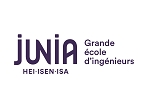Establishment
Language of instruction
French, English
Teaching content
MB-ST
Training officer(s)
D.BOULINGUEZ
Stakeholder(s)
D.BOULINGUEZ, Laurent CLAVIER, Virginie DENIEAU, Wadih SAWAYA, Yves DELIGNON
Présentation
Prerequisite
Advanced techniques for telecommunications requires knowledge of basic communications / digital transmissions on the digital modulation techniques, the computing performance of a transmission. (course code: ISEN-M1P2-msnn-MFO-CommunicationsNumeriques)
Goal
This course aims to deepen specific processing to digital transmissions.
At the end of the module, students will
- Master the concepts and current technical for information coding (source coding and channel coding)
- Know the usual techniques of digital transmission in case of multiple users
In a second time, this course aims to present possible techniques to fight against the multipath propogation in a transmission channel, this particular problem in mobile radio communications.
At the end of this course, the student will be able to control two main approaches and choose the best for a given transmission system and implement it.
At the end of the module, students will
- Master the concepts and current technical for information coding (source coding and channel coding)
- Know the usual techniques of digital transmission in case of multiple users
In a second time, this course aims to present possible techniques to fight against the multipath propogation in a transmission channel, this particular problem in mobile radio communications.
At the end of this course, the student will be able to control two main approaches and choose the best for a given transmission system and implement it.
Presentation
The course is divided into two parts:
The first part is about information coding :
- Encoding information: basic concepts and current techniques for source coding and error correction coding (coding Viterbi, Turbo codes ...)
- Techniques for multiple access: basic concepts allowing multiple users in digital transmissions. Presentation of different technologies (TDMA, FDMA, CDMA ...)
The second part is about multipath tranmission :
This course addresses two possible techniques to fight against the harmful effects of multupath progagation on a channel. This phenomenon is particularly strong presence in mobile radio communications.
The first approach relates to the modulation multicarrier illustrated mainly through OFDM, known for its use in ADSL. This approach aims to solve the problems of multipath from the offering to better withstand the adverse effects (ie high error rate of transmission).
The second approach relates to techniques for channel equalization. This approach aims to reverse the effects of the channel and therefore acts mainly in the receiver.
Many illustrations will be made from existing telecom systems.
Finally, a more general point in telecommunications will be covered in this module and will cover electromagnetic compatibility.
The first part is about information coding :
- Encoding information: basic concepts and current techniques for source coding and error correction coding (coding Viterbi, Turbo codes ...)
- Techniques for multiple access: basic concepts allowing multiple users in digital transmissions. Presentation of different technologies (TDMA, FDMA, CDMA ...)
The second part is about multipath tranmission :
This course addresses two possible techniques to fight against the harmful effects of multupath progagation on a channel. This phenomenon is particularly strong presence in mobile radio communications.
The first approach relates to the modulation multicarrier illustrated mainly through OFDM, known for its use in ADSL. This approach aims to solve the problems of multipath from the offering to better withstand the adverse effects (ie high error rate of transmission).
The second approach relates to techniques for channel equalization. This approach aims to reverse the effects of the channel and therefore acts mainly in the receiver.
Many illustrations will be made from existing telecom systems.
Finally, a more general point in telecommunications will be covered in this module and will cover electromagnetic compatibility.
Modalités
Organization
| Type | Amount of time | Comment | |
|---|---|---|---|
| Face to face | |||
| Lectures - face to face | 55,00 | ||
| Lab | 4,00 | ||
| Independent study | |||
| Independent study | 80,00 | ||
| Overall student workload | 139,00 | ||
Evaluation
| Control type | Duration | Amount | Weighting |
|---|---|---|---|
| Final Exam | |||
| Intermediate exam | 4,00 | 2 | 60,00 |
| Others | |||
| Mini-project | 20,00 | 1 | 40,00 |
| TOTAL | 100,00 | ||






